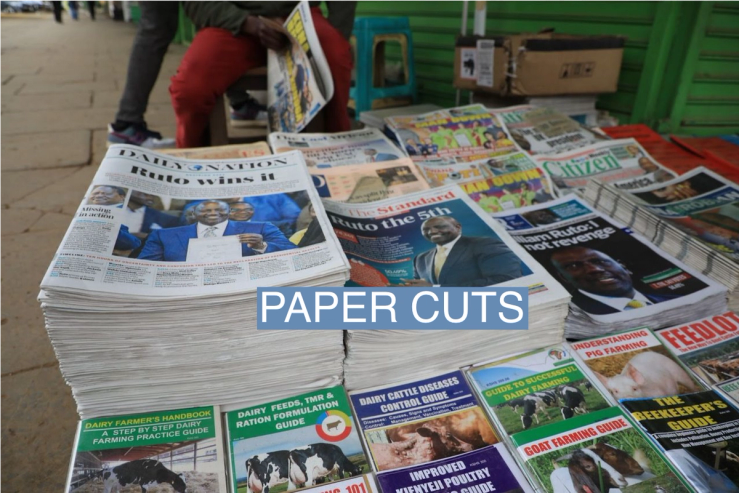The Scoop
NAIROBI — Executives at two of Kenya’s largest media houses are considering legal challenges to what they believe is a politically-charged move to centralize government advertising.
The executives at Nation Media Group (NMG) and Mediamax fear the move by President William Ruto’s administration could starve them of much-needed revenues and boost a more sympathetic rival, sources close to the discussions have told Semafor Africa.
Late last year, the Ruto administration awarded a two-year contract for the printing and distribution of MyGov, a pullout magazine containing government advertisements, to The Star, which is Kenya’s fourth most-read newspaper with only 3% of the market in 2022, behind The Nation, Standard, and Kiswahili language publication Taifa Leo. The Star had the lowest bid for the tender, at 9 million Kenyan shillings ($55,000) per weekly edition.
The Nation, The Standard, and Mediamax’s People Daily, which had previously co-distributed MyGov, all bid for the new contract, quoting prices between two to three times higher, according to a government source.
A circular dated Jan. 23 informed officials of ministries and agencies that they would not be able to advertise in any other publication besides The Star. Distribution of the government magazine by The Star began in January. To boost circulation, The Star made its Tuesday edition, which contains the pullout, completely free.
The Government Advertising Agency did not respond to queries from Semafor Africa. David Omwoyo, chief executive of the Media Council of Kenya (MCK), the independent industry regulator, told Semafor Africa that the body had not yet received any formal complaints related to The Star’s publication and distribution of MyGov.
In this article:
Know More
Government advertising accounts for around 30% of the revenues of major newspapers in Kenya. As in much of the rest of the world, however, print circulation has been steadily declining and legacy media companies are feeling the pinch.
Ruto’s administration is keen on halving the government’s overall advertising, which would further impact major media houses. The government has also been under pressure to pay the 1.7 billion Kenyan shillings ($10.5 million) it owes media companies in Kenya for services already rendered, with media houses blaming the delayed payments for exacerbating financial pressures on them.
Martin’s view
Since his campaign for President in 2022, Ruto has made no secret of his feeling that Kenya’s biggest media companies are against him. This isn’t entirely surprising as some of them, such as Mediamax and Standard, are associated with his political rivals, the Kenyatta and Moi families.
The Star, by contrast, has reported links to his allies, including former Nairobi Governor Evans Kidero, and Ruto’s administration is considered to have more sway with the media house.
Now Ruto’s critics view the administration’s move to centralize its advertising with The Star as an attempt to kneecap rival companies at a time when everyone is struggling to keep up with a constantly evolving media landscape.
And there’s no doubt the move will be felt. Standard Group posted a 147 million Kenyan shillings ($900,000) pre-tax loss in the half year to June 2023 and went several months without paying its journalists, while Nation Media Group saw its profit decline 98.8% in the same period. It issued a profit warning last October, expecting its annual earnings to fall by more than 25% in 2023.
Denting these companies’ earnings could curtail their ability to play their role of public watchdog in a healthy democracy. And given Ruto’s ongoing battle with the judiciary, it would mean that another crucial institution tasked with helping keep Ruto’s administration accountable faces a major threat.
“Even if we win (the potential legal challenge), they might just defy court orders,” one media executive said privately, referencing Ruto’s promise to defy the courts which have issued various rulings stopping implementation of some of his policies.
Newspaper houses, however, also find themselves to blame for failing to develop other strong revenue streams to reduce the significance of government spending to their bottom lines. The government’s latest move is likely to accelerate this diversification and digital innovation.
Room for Disagreement
Prof. Edward Kisiang’ani, principal secretary in the ICT ministry, cast the move in economic terms at a press conference on Jan. 31. He said Convergence Media, the company behind The Star, had presented the lowest bid. He denied claims that the tender process was flawed. Kisiang’ani added that the government was ‘contemplating’ shifting to digital channels for its advertising, and said media companies “can no longer continue investing in print as a source of revenue.”
Notable
- The Mexican government’s ad budget of hundreds of millions of dollars has in the past caused public officials to exert influence over the media and its coverage of important stories in the country.


